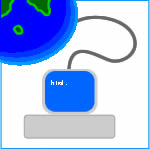Setting up a webserver with a dynamic IP address
(Printable Version)

Operating System: Windows
Although this tutorial does not relate to 3D modelling / animation directly, I thought there might be people out there looking to set up their own webpage on there computers at home. Be aware that you will not be indexed in search engines however the process is completely free.
Step 1: Acquire a Domain Name
The first thing to do is to acquire a domain name. This will be a subdomain of another persons domain. There are a number of Free Dynamic DNS updaters out there. In this example i will be using freedns.com
a) Create a new account at freedns.com
b) Log into your account and click on the subdomain link item on the left hand side of the screen.
c) Click the add button to create a new subdomain.
d) Fill in the form that appears. For type select A. For Subdomain type www.<name> where <name> is the name of your website then pick any public domain from the drop down list below.
So for example if you typed in "www.john" for your subdomain, and selected mooo.com from the list of available domains, your websites URL would look like this:
Step 2: Automatically Update your Dynamic IP Address
Because dynamic ip addresses change sometimes (hence the name) for example, whenever your router resets, you need to have someway of telling the external DNS server (mooo.com) whenever this occurs. To do this, we will be installing a small program that will periodically check if your ip address has changed and update it automatically. (Dont be too concerned if you dont quite understand what im talking about here).
1) Still on the freedns.com website: click on dynamic dns link on the left hand side of the webpage
2) On the page that loads client on the dynamic dns clients
3) Under the "windows clients" heading, select the freedns update program in the list.
4) Download and install this program.
5) In your Program Files menu, go into the Freedns Update program group and select the Freedns Update (install service) shortcut. This will load freedns update everytime your computer boots up ie it will run all the time.
6) Load Freedns Update (the program).
7) Click on the settings tab.
8) Enter your Freedns.com Username and Password
9) Click the update now button.
This program will check your external IP addres periodically. If it notices a change, it will inform the external DNS server (example: mooo.com) that your IP address has changed, and will update it to the new one (so people can find your webpage).
Step 3 - Install a Webserver
There are a number of webservers out there too. The most common and free webserver is Apache. In this tutorial i will be using a webserver called Abyss. Abyss uses the apache core and is a great webserver package for people that do not know alot about webservers and best of all the X1 version is free!
a) Download and install Abyss Webserver x1 -
If during installation you are prompted for "abyss webserver startup configuration" select install as a service and check start automatically on computer startup. Click ok.
If not...Load Abyss Webserver Click on the server menu item then select start up configuration. In the list that appears select install as a service and check start automatically on computer startup. Click ok.
b) The access credituals screen should appear after installation is complete. Enter a username and password for the console. If it doesnt appear it can be accessed through the Abyss main screen: select console then show
Step 4 - Setup Abyss Webserver
Although there are tonnes of settings that you can change to your preferrence here, i will just be explaining the basics so that you can get your server up and running.
a) Log into the console with the username and password you just entered.
b) Click on the configure button for "default host on port ..."
c) Click on the general icon and change the port number to 80. This assumes that your broadband provider does not block port 80. Please check with your provider for this information.
d) Copy or create a webpage inside the htdocs folder inside the Abyss directory. So for the default installation this directory is C:\Program Files\Abyss Web Server\htdocs.
Step 5 - Forwarding port 80
For the final step you will need to access your firewall and forward port 80 to your webservers IP address, ie, the computer you installed Abyss onto. Unfortunately due to the massive range of routers and computer configurations out there, i will not be able to explain this step to you. I would suggest for further information on port forwarding to read your router manual or search on google for more help with this final step.
Finish
Congratulations! You made it! I hope that this tutorial has helped you to understand how to set up and configure a webserver. This is the basic set up i followed to learn about webservers and found it one of the easiest ways to learn the basics without being thrown in the deep. If you have any questions about the process, please feel free to email me and i will try my best to answer your questions.
![]() Abyss is a great place to start, but if want to advance your web administering skills, I highly recommend the Apache webserver. Although not as easy to use, it is alot more configurable.
Abyss is a great place to start, but if want to advance your web administering skills, I highly recommend the Apache webserver. Although not as easy to use, it is alot more configurable.
Good luck and thanks for reading!
Chromesphere.com

